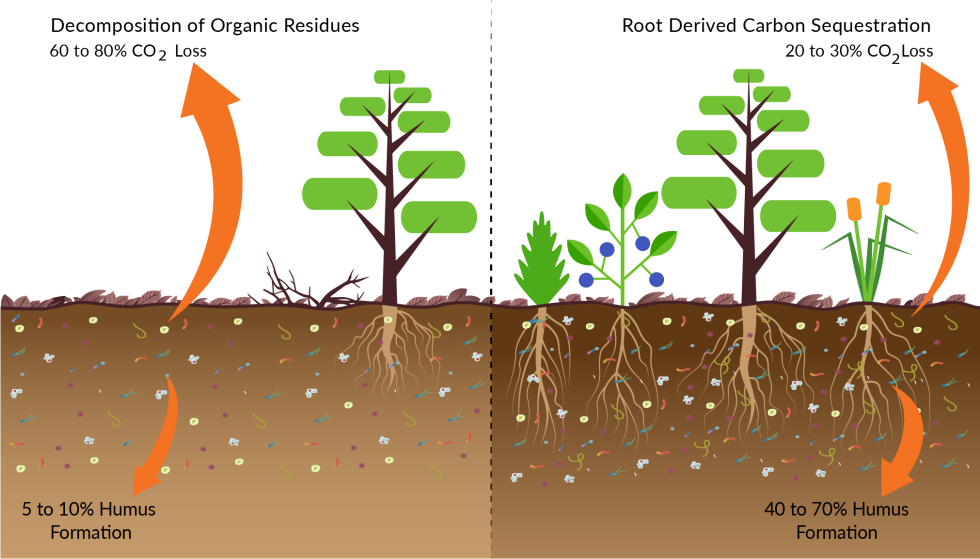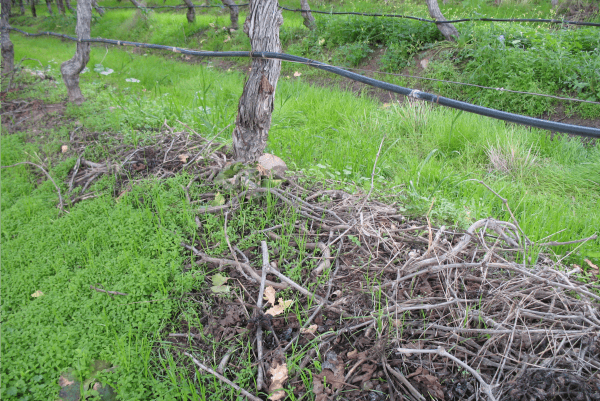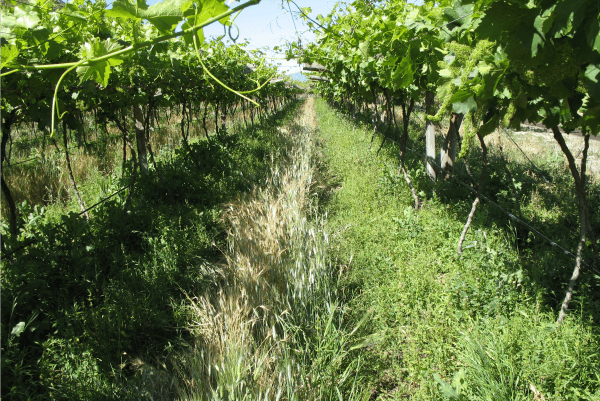- +27 (0)21 848 9434
- marketing@ecosoil.co.za
- Mon - Fri: 8:00 - 16:30
Soil Building Process
Soil building is a plant driven process whereby carbon is sequestered from the atmosphere and locked into the soil and in so doing, changes the overall biological, chemical and physical properties of the soil – in a beneficial way.
Soil organic matter can be divided into 3 parts – the living, the dead and the very dead.
The living part – huge diversity of micro-organisms, such as bacteria, viruses, fungi, protozoa, algae and nematodes; also, plant roots, insects, earthworms, and larger animals.
The dead part – dead plant roots, crop residues, root exudates, deceased micro and macro organisms, and animal manures. This is the active, or easily decomposed, fraction of organic matter that is the main supply of food for the various organisms.
The very dead part – humus – very stable, complex and well-decomposed organic matter. Humus is an organo-mineral complex comprising about 60% carbon and between 6 and 8% nitrogen, phosphorus and sulphur. Proportionally, it has a huge surface area and can store both cations and anions and is an essential factor in soil fertility. These organo-mineral complexes form a stable and inseparable part of the soil matrix that can remain intact for hundreds of years.
The ultimate goal in soil building is the formation of humus.
There are 2 pathways whereby humus can be formed and they differ substantially in their effectiveness.
1. Pathway One is the decomposition of organic materials such as – crop residues and manures
To obtain the energy contained in cellulose, lignin, starches, oils or other compounds formed by plants, microbes have to break this material down. This is called mineralisation. In so doing, between 60 and 80% of this carbon is released as CO2 back to the atmosphere through a process called oxidation and respiration. The efficiency of this process is determined by the digestibility of the material, the microbial community present, soil moisture content and other environmental conditions.
The type of vegetation also has a major impact on the amount of carbon sequestration. In forest soils, most of the soil organic matter (SOM) is distributed in the top few centimetres, mostly as a result of leaf litter. Tree roots are high in lignin and do not die off on a regular basis and thus do not contribute much to SOM. In comparison, tall grasses form deep fibrous root systems of which 50% die off yearly. Their decomposition happens at depth and thus these soils are high in SOM throughout the soil profile making them highly productive because they hold more nutrients, contain more microbes, and have better soil structure due to larger fungal populations.
2. Pathway Two is liquid carbon exudates resynthesised into highly complex carbon polymers
The carbon found at the soil surface are mostly short-chain, labile (easily altered, less stable) carbon, indicative of rapid turnover. This is the active carbon that is important for the health of the soil food-web. In recent scientific studies it was found that on average only 8,3% of this carbon was converted to stable soil humus.
The carbon in root exudates is already in a useable form for microbes. Very little carbon loss occurs through respiration (CO2 release) and virtually no losses occur through oxidation. The same study found that on average 46% of root-derived carbon was stabilised making this pathway 5 times more efficient than the Pathway One alternative involving ground biomass. The liquid carbon pathway allows for carbon sequestration deeper down in the soil profile, building top soil at depth, so to speak. The deeper the sequestration, the greater the likelihood that the carbon will be protected from oxidative and/or microbial decomposition.
two pathways of carbon sequestration

Every green plant is in effect a solar-powered carbon pump and it is the photosynthetic capacity and the photosynthetic rate of plants that drives the sequestration of stable soil carbon. If plants are force fed with inorganic fertilisers, it shuts off this pump. Reduced carbon flows consequently impact a vast network of microbial communities, restricting the availability of essential minerals, trace elements, vitamins and hormones required for plant tolerance to environmental stresses such as frost, drought and resistance to insects and disease. Decreased nutrient densities in plants also translate to reduced nutritional value of food – a deadly and futile downward spiral of soil degradation.
PRACTICAL IMPLICATIONS
The use of inorganic fertilisers can be minimised by using it in conjunction with organic fertilisers, organic acids and Compost Tea. This will prevent the shut down of the carbon pump and will counter the oxidation of soil carbon.
Living plants are at least 5 times more efficient at building soil carbon than the decomposition of mulches. It is the photosynthetic capacity and the photosynthetic rate of plants that determines the effectiveness of the process.
Photosynthetic capacity is the amount of light intercepted in a given area. This can be optimised through the use of multi-species crops, stacking different height plants together. For instance, in fruit orchards diverse under-storey cover crops or weeds can be utilised to increase light interception and thus root exudates. Bare soil has zero photosynthetic capacity, is detrimental to soil health and should be avoided at all costs. The more active green leaves there are and the more roots there are, the more carbon is added.

Carbon sequestration is less efficient with crop residues

Carbon sequestration is more efficient with cover crops
With pastures it is recommended that stock be bunched into large mobs and moved frequently. During the grazing period (usually one to three days), a useful guide is to aim for approximately 20% of the available forage to be trampled to form surface litter and approximately 20% to be left standing (ie. no more than 60% utilised for animal consumption). This will prevent that palatable forage is overgrazed and will ensure that enough photosynthetic capacity remains for regrowth.
Treating fruit trees with Ecosoil’s Compost Tea will make them more complex, resulting in more shoots but shorter and more productive trees. Since the overall growth is more, this will increase the photosynthetic capacity.
Photosynthetic rate is the rate at which plants are able to convert light energy into sugars. There are many factors playing a role here – light intensity, temperature, moisture, nutrient availability, plant health, as well as microbial communities around roots and on leaf surfaces. Photosynthetic rate can be assessed by measuring sugar (Brix) levels with a refractometer. Diverse microbial communities perform soil functions that increase the photosynthetic rate of plants, increasing their mineral and sugar content and making them less prone to pest and disease. This in turn allows for more liquid carbon exudates, that in turn improves soil fertility and offers an upward spiral of soil regeneration.
